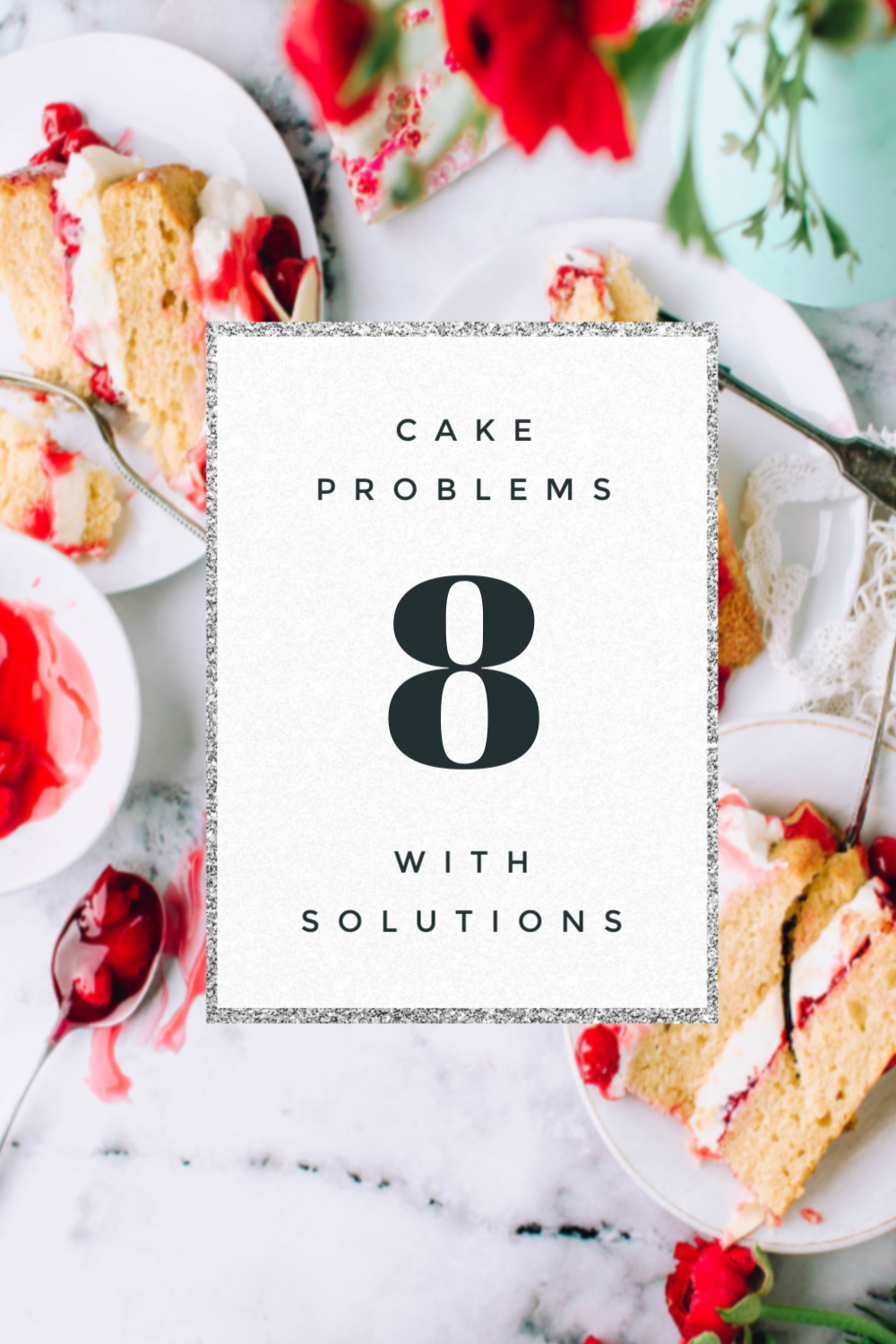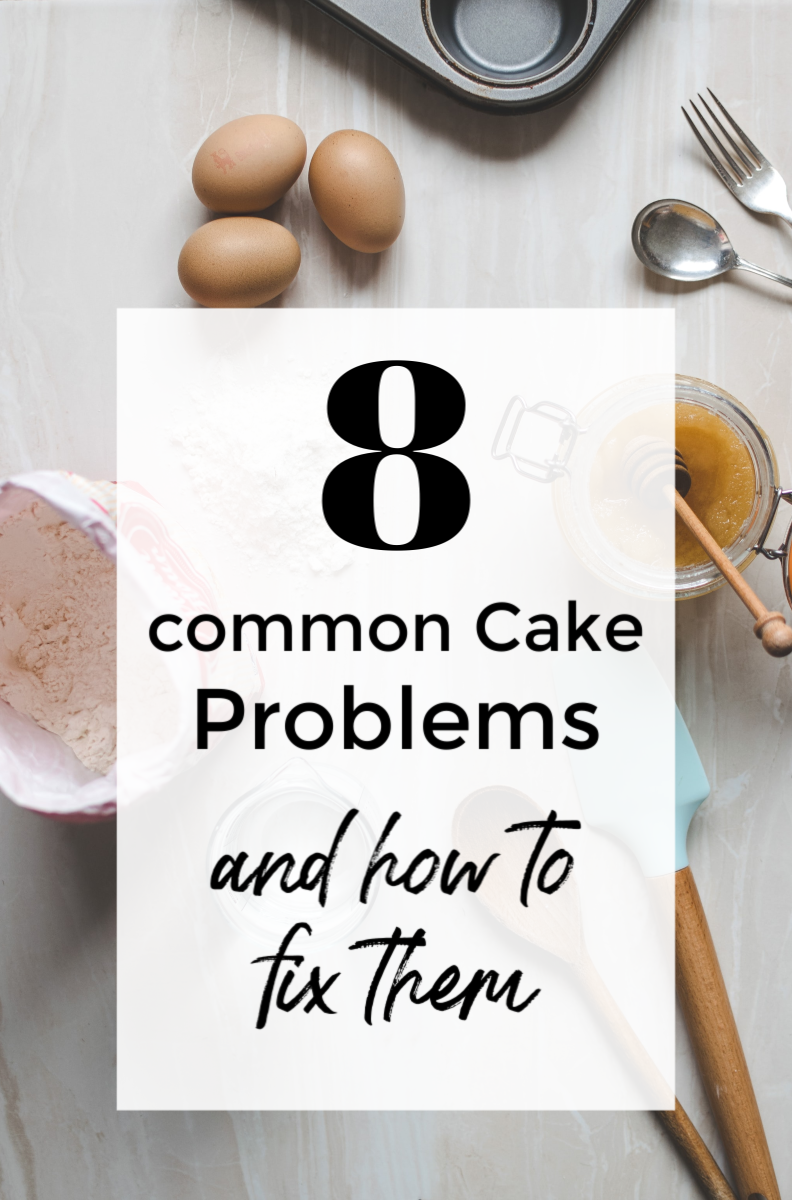BAKING CAKES: PROBLEMS AND TIPS
This post may contain affiliate links that won’t change your price but will share some commission.
Baking Cakes: Problems and Tips, this post is about common cake-baking problems and why they happen. You’ll get some helpful cake troubleshooting tips and easy ways to keep those cake-baking fails from happening.
With these cake-baking tips, you’ll know how to avoid all the pitfalls that bakers face.

Baking Cakes: Problems and Tips
If the cake falls (sinks in the middle):
- Oven not hot enough
- Under mixing
- Opening the oven door during baking
- Too much leavening, liquid, or sugar
You got to calibrate your oven so that it’s reading the correct temperature.
As well, carefully read and measure your leavening agents.
If cake peaks in the center:
- Oven too hot at the start of baking
- Too much flour
- Not enough liquid
Your cake sticks to the pan:
- Cake cooled in the pan too long
- Pan not greased and floured properly
You can use parchment paper to line the pan which will help. Also, use solid vegetable shortening and granulated sugar or flour or Wilton cake release to coat the pan. The non-stick spray works ok for layer pans, but I don’t like it for pound cakes.
For layer cakes, cool them in the pan for 10 minutes before turning them out. For pound cakes, cool them for 20 to 30 minutes before turning them out. (Pound cakes are so dense it takes longer to cool. If you turn them out too soon they can break.)
Cake cracks and falls apart:
- Removed from the pan too soon
- Too much shortening, leavening, or sugar
Crust is sticky:
- Insufficient baking
- Oven not hot enough
- Too much sugar
If the texture is heavy (dense) or ‘gummy’:
- Overmixing when flour and liquid added
- Oven temperature too low
- Too much shortening, sugar, or liquid
- The ingredients weren’t at room temperature
How to prevent it in the future
- Properly measure your flour by fluffing it, then spooning and leveling each cup.
- Mix your batter just until the ingredients are incorporated after you’ve added the flour. Over-mixing causes gluten strands to form giving your cake that dense texture.
- Cold ingredients are more difficult to mix together causing you to overmix the batter. They also affect your cake rising.
If the texture is coarse:
- Inadequate mixing or creaming
- Oven temperature too low
- Too much leavening
If the texture is dry:
- Over baking
- Over-beaten egg whites
- To much flour or leavening
- Not enough shortening or sugar
How to prevent a dry cake – Cakes keep baking for a few minutes after you remove them from the oven. If the toothpick comes out clean, your cake may already be overbaked. Next time take your cake layers out a few minutes earlier even if the pick has a few moist crumbs. Make detailed notes on time, temperature, and what pan you used for next time.
Baking Cakes: Problems and Tips
Measure accurately. Extra sugar or leavening causes a cake to fall; extra flour makes it dry.
Have ingredients at room temperature for maximum volume.
Beat softened
Use name-brand ingredients. Store brands of sugar are often more finely ground than name brands resulting in more sugar per cup. This can cause a cake to fall. Store brands of
Add eggs 1 at a time, beating the batter just until the yellow yolk disappears.
Always add dry ingredients alternately with the liquid to prevent the batter from curdling. Begin and end with dry ingredients. Mix until just blended after each addition. Over-mixing will result in a tough, rubbery cake.
Always use the correct type of cake pan. For instance, a Bundt pan and a

More Tips for Baking Cakes: Problems and Tips
Grease cake pans with solid vegetable shortening and dust with flour or sugar. A non-stick spray is often too slippery. A slippery surface keeps the batter from rising to its full volume.
Calibrate your oven to check for temperature accuracy.
Bake cakes in the center of the oven and keep the door closed. Check the cake at the minimum time suggested if more cooking time is needed gently close the door as quickly as possible after testing.
Fill cake pans 2/3 full and spread batter into corners and sides, leaving a slight hollow in the center.
To prevent domes in the center of your cake, use Even-bake strips.
The cake is done when it shrinks from the sides of the pan or if it springs back when touched lightly with the finger.
After removing a cake from the oven, place it on a rack for about five minutes for layer cakes, and 15 to 20 for pound cakes. Then, the sides would be loosened and the cake turned out on a rack in order to finish cooling.
Do not frost cakes until thoroughly cool.
Icing will remain where you put it if you sprinkle cake with powdered sugar first.
As an Amazon Associate, I earn from qualifying purchases. This post contains affiliate links. If you click the link and make a purchase I will receive a small commission at no cost to you. Visit all my recommended products at Paula’s Picks on Amazon. Read my entire Privacy Policy here.

Hi,
Apologies if this has been asked and answered, but I am curious. Some pound cake recipes call for a 350 degree oven with 70 or so minutes for baking. Others call for a 325 degree oven with more time for baking. Which is better or is there a difference? Thanks!
I honestly can’t tell a difference in taste or texture. Sometimes I’m just in a hurry and bake them at 350 but most of the time I bake at 325